|
|
|
|
Report on Allied Contributions to the Common Defense
A Report to the United States Congress by the Secretary of Defense
U.S. Department of Defense
March 1997
III. Assessment of Country Contributions
This chapter presents the Department’s assessment of allied and partner countries’ contributions in the four areas specified in the FY 1997 Defense Authorization Act. The responsibility sharing targets established by this legislation are:
Increase military assets contributed to or earmarked for multinational military activities.
Increase offsets for U.S. stationing costs to a level of 75 percent by the year 2000.
Increase foreign assistance by 10 percent over the previous year, or to a level commensurate with that of the United States.
The following assessments are based on the latest and most complete unclassified data available. Notes on uses, limitations, and sources of these figures, and a country–by–country summary of selected responsibility sharing statistics, can be found in the annex.
Defense Spending as a Percent of GDP
Defense spending relative to GDP combines the most comprehensive indicator of defense effort with the most comprehensive indicator of ability to contribute. However, this indicator should not be viewed in isolation from other national contributions to shared security objectives, because it does not in itself resolve the issue of equity. One could argue, for example, that per capita GDP should be factored into the equation, on the logic that it is fairer for nations with the strongest economies and wealthiest populations to carry a proportionately larger share of the burden of providing for the common defense.
Any attempt to assess responsibility sharing must therefore consider nations’ contributions to the common defense in terms of their ability to contribute. This is a sound principle made all the more important by large differences in economic performance, population, and standards of living that exist among our allies. Chart III–1 shows the wide range of per capita GDP among the nations addressed in this Report—from $2,600 in Turkey to $37,000 in Japan. The chart also shows that many nations with below–average per capita GDP spend above–average shares of GDP on defense, including all of the GCC countries, Turkey, the Republic of Korea, Greece, and the United Kingdom. Conversely, some nations that have above–average standards of living spend below–average shares of their GDP for defense, including Japan, Luxembourg, Denmark, Germany, Belgium, and the Netherlands.
Chart III–1
1996 Per Capita GDP (In Thousands of Dollars)
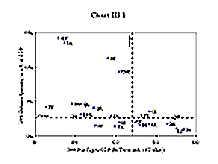
(view full–size chart)
Current Defense Spending/GDP Ratios
Defense budgets around the world are generally in decline, due to competing post–Cold War priorities and tightening financial constraints. This is exacerbated in Europe by the pressure to meet rigorous European Monetary Union (EMU) budget criteria, as well as by country–specific economic difficulties (e.g., Germany’s continuing unification costs—estimated by Germany at over $100 billion per year—and its unemployment rate in excess of 10 percent).
Chart III–2 depicts defense spending trends from 1990–1996 for the United States, our NATO and Pacific allies, and our GCC partners. Calculated on the basis of constant 1996 U.S. dollars and exchange rates, U.S. defense spending decreased by 25 percent from 1990 through 1996, while in comparison, Germany’s decreased by 28 percent, the U.K.’s by 25 percent and France’s by 10 percent. In contrast, four NATO nations registered notable real increases in their defense budgets—Turkey (14 percent), Luxembourg (10 percent), Greece (10 percent), and Portugal (6 percent)—over this period, as did the Republic of Korea (24 percent) and Japan (13 percent). Trends for our GCC partners during this time frame cannot be compared due to sharp distortions caused by the Gulf war.
Chart III–2
Defense Spending (1996 Dollars in Billions – 1996 Exchange Rates)
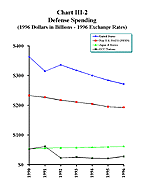
(view full–size chart)
In some cases, expenditures outside of defense budgets promote shared security interests (for example, Germany’s investments in the infrastructure of eastern Germany, its financial support for economic and political reform in the new democracies in Central Europe, and the costs it bears to absorb refugees from the former Yugoslavia). Nonetheless, we are concerned about current and prospective levels of defense spending in Europe, and continue to urge our allies to maintain defense budgets at appropriate levels and reverse negative trends in spending. Effective military capabilities are at issue here, as is the fact that our transatlantic partnership requires a more balanced level of investment in collective security.
Chart III–3 shows the percentage of GDP spent on defense by U.S. allies in 1996. Chart III–4 reveals that the overall pattern of U.S. and allied defense spending relative to GDP in 1996 remained much the same as it has been in recent years: the GCC nations, along with Greece and Turkey, spent the highest percentage of their GDP on defense, while Japan, and several of our NATO allies (Luxembourg, Canada, Spain, Belgium, Germany, and Denmark) spent the least.
| Chart III–3 |
|
Chart III–4 |
| Defense Spending as a Percent of GDP (1996) |
|
Defense Spending as Percent of GDP |
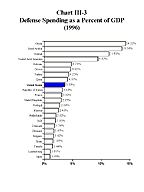
(view full–size chart) |
|
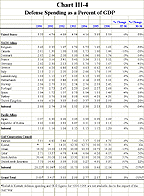
(view full–size chart) |
In 1996, Greece and Turkey once again exceeded all other NATO nations in defense spending relative to GDP, and Greece was also one of only four Alliance members that experienced growth in this indicator (4 percent) during 1996—the other three are Italy (10 percent), Portugal (4 percent), and Norway (2 percent).
The remaining NATO members spent less of their GDP on defense in 1996 than the United States. It should be noted, however, that since 1990, non–U.S. NATO defense spending relative to GDP has risen from 54 percent to 61 percent of the U.S. level.
France and the United Kingdom are consistently among the leading NATO nations in terms of defense spending as shares of GDP, trailing only Greece, Turkey, and the United States in this measure in 1996. As mentioned above, German defense spending has been particularly hard hit by rigorous EMU demands and the ongoing costs of unification.
Although the percentage of Japan’s GDP spent on its constitutionally–limited defense forces remained at just 1 percent in 1996, Japanese defense spending still recorded a 3 percent real increase over 1995 due to GDP growth. Japan’s defense budget remains the third largest of all the countries in this Report, behind those of the United States and France.
Although the Republic of Korea’s defense spending as a percentage of GDP declined by 2 percent between 1995 and 1996, its defense budget experienced a real increase of over 5 percent—one of only a handful of countries in this Report to do so.
The six GCC nations present a mixed picture, since Oman, Bahrain and Qatar cut their defense spending relative to GDP during 1996, while Kuwait, Saudi Arabia and the UAE increased theirs (the latter two by 30 and 90 percent, respectively).
Defense Spending/GDP Contributions Compared With Congressional Targets
In the FY 1997 Defense Authorization Act, Congress established two targets for our allies in the area of defense spending relative to GDP: increase this ratio by 10 percent compared to the preceding year, or achieve a level of defense spending as a percentage of GDP commensurate to or exceeding that of the United States. Based on the foregoing analysis, Chart III–5 lists those nations that achieved one or both of these targets in 1996.
|
|
Defense Spending / GDP Ratio Increased by 10% |
Defense Spending / GDP Ratio
Exceeds or Commensurate to U.S. Level |
| Bahrain |
|

|
| Greece |
|

|
| Italy |

|
|
| Kuwait |
|

|
| Oman |
|

|
| Qatar |
|

|
| Saudi Arabia |

|

|
| Turkey |
|

|
| UAE |

|

|
Apart from the countries shown in Chart III–5, several other nations have also made notable efforts in the area of defense spending. As already mentioned, the Republic of Korea, Japan, Luxembourg, and Portugal have achieved real defense spending growth over the 1990–1996 period. In addition, ROK, France, and the United Kingdom continue to contribute shares of defense spending that substantially exceed their relative shares of GDP.
Multinational Military Activities
A broad range of political, economic, and ethnic instabilities threatens areas of vital strategic interest to the United States and its allies. Efforts to defuse these potential challenges, or to manage them as necessary, have become increasingly important for the preservation of U.S. national security and fundamental Western values. Thus, in the years since the end of the Cold War, the United States and its allies have engaged in multinational peacekeeping and humanitarian relief operations on an unprecedented scale. During 1996, for example, U.S. and allied military personnel served in such operations in Bosnia, Croatia, Macedonia, Lebanon, Haiti, and Angola.
Current Multinational Military Contributions
The Department’s assessment of countries’ contributions to multinational military activities addresses the commitment of specialized forces to multinational defense missions, as well as participation in and funding for UN peace support operations.
In the area of specialized force commitments to multinational defense, by far the most substantial contributions are made by our NATO allies. In response to the post–Cold War security environment, NATO adopted a new strategic concept in 1991 which directed Alliance members to develop forces that can be rapidly transported to remote theaters of operations; function despite a lack of pre–established lines of communication and host nation support; and fight effectively in multinational formations at the corps and even division level. NATO nations are beginning to restructure their military forces accordingly, and have created Reaction Forces that are organized into multinational commands and formations such as the Allied Command Europe (ACE) Rapid Reaction Corps (ARRC) and the NATO Air Transport Pool. Most Alliance members provide ground Reaction Forces, and also make contributions to NATO’s air and naval Reaction Forces. Nations’ commitments to NATO’s ground reaction forces, drawn from unclassified sources, are shown in Chart III–6.
| NATO Member | Combat Brigade Equivalents | Support Brigade Equivalents |
| Belgium | 4 |
|
| Denmark | 1 | 0.2 |
| France | 3 |
|
| Germany | 7 |
|
| Greece | 3 |
|
| Italy | 4 | 1.9 |
| Netherlands | 1 | 0.7 |
| Portugal | 1 |
|
| Spain | 7 |
|
| Turkey | 3 | 0.3 |
| United Kingdom | 7 | 7.0 |
| United States | 3 | 2.4 |
| TOTAL | 44 | 12.5 |
The experience gained by NATO’s Reaction Forces in the former Yugoslavia, and the continuing development of the Combined Joint Task Force (CJTF) concept, clearly demonstrate that NATO’s integrated planning and operational framework provides substantial multinational military capability for contingencies worldwide.
In contrast, due to the much different security situation in the Pacific and the unique defense capabilities of Japan and the Republic of Korea, our responsibility sharing policy in this region has emphasized cost sharing rather than global military roles and missions. Nevertheless, we are encouraged by Japan’s 1995 agreement to increase its role in regional affairs, and by the Republic of Korea’s steady force modernization and assumption of increased command responsibilities for combined U.S.–ROK forces.
With the encouragement of the United States, our GCC partners are taking steps to strengthen provisions for multilateral defense of their crucial region by expanding their standing Peninsula Shield force, and increasing the frequency of multinational exercises. The United States is also working with the GCC to overcome impediments to closer military cooperation with other Arab nations.
| Chart III–7 |
|
Chart III–8 |
|
UN Peace Support Personnel Share Relative to Labor Force Share (1996)
|
|
UN Peace Support Funding Share Relative to GDP Share (1996)
|
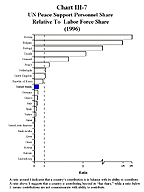
(view full–size chart) |
|
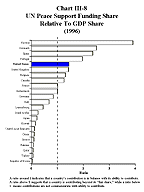
(view full–size chart) |
These charts reveal that—along with Norway—Belgium, Portugal, Canada, and Denmark likewise provide disproportionately large shares of support in both peacekeeping personnel and peacekeeping funding. France, the U.K., and the Netherlands are average or above average in both categories, while Spain’s contributions are well above average in the area of funding for UN peacekeeping missions. The contributions of our remaining NATO and Pacific allies are below par in both categories, while the level of support provided by the GCC nations is extremely low. The United States provides financial support for peace operations at a slightly higher level than its relative ability to contribute, but its personnel contribution is relatively much smaller than its share of the overall labor force.
Multinational Military Contributions Compared With Congressional Targets
One of the objectives established by Congress in the FY 1997 Defense Authorization Act was for U.S. allies to increase the assets (including personnel, equipment, logistics, and support) that they contribute, or are prepared to contribute, to multinational military activities worldwide.
The Department of Defense believes that accepting military roles and tasks as part of an alliance or coalition is the most meaningful measure of a country’s willingness to participate in multinational military missions. Unfortunately, however, it is very difficult to assemble such information—complete, comparable, and unclassified—for all nations addressed in this Report. Therefore, for purposes of assessing contributions in terms of the Congressional target, we have compared nations’ efforts in support of UN peace operations. Countries that increased their contributions to UN peace operations in 1996 from 1995 (relative to their ability to contribute) are shown in Chart III–9.
|
|
Ratio Increased |
Ratio Increased |
| Belgium |

|
|
| Canada |

|
|
| Germany |

|
|
| Greece |

|
|
| Portugal |

|
|
| Qatar |
|

|
| Spain |

|
|
| Turkey |

|

|
Turning to participation in UN peacekeeping missions, a number of our NATO allies make very substantial contributions relative to their ability to contribute, with Norway leading all other nations in both funding and personnel support for peacekeeping. This is shown in Chart III–7 (which depicts each nation’s share of total manpower contributed to peacekeeping missions compared to its share of total labor force) and Chart III–8 (which shows each nation’s share of total funding contributed for peacekeeping missions compared to its share of total GDP).
The most familiar form of cost sharing is bilateral cost sharing between the United States and an ally or partner nation that either hosts U.S. troops and/or prepositioned equipment, or plans to do so in time of crisis. The Department of Defense distinguishes between two different types of bilateral cost sharing: the direct payment of certain U.S. stationing costs by the host nation (i.e., on–budget host country expenditures), and indirect cost deferrals or waivers of taxes, fees, rents, and other charges (i.e., off–budget, foregone revenues).
Current Cost Sharing Contributions
As shown in Chart III–10, the Department estimates that in 1995 the United States received direct and indirect cost sharing assistance from our NATO, Pacific, and GCC allies totaling $8.3 billion. (Note: the latest available cost sharing figures are 1995 estimates, expressed in 1995 dollars).
Cost sharing has been a particularly prominent aspect of our bilateral defense relationships with Japan (since the late 1970s) and the Republic of Korea (since the late 1980s). As Chart III–10 shows, Japan provides a greater level of direct cost sharing than we receive from any other ally. This is due largely to the strict constitutional limits that apply to the Japanese armed forces, and concerns for regional stability shared by the United States, and Japan and its Asian neighbors. Refer to the previous chapter for additional details on Japanese cost sharing.
The Republic of Korea first agreed to contribute to a program for Combined Defense Improvement Projects (CDIP) construction in 1979—which marked the beginning of our present cost sharing relationship. In 1988, the Republic of Korea agreed to a CDIP program funded initially at $40 million a year. Since that time, annual cost sharing negotiations have brought a gradual increase in ROK cost sharing. During 1995, the ROK provided $300 million in direct cost sharing and $1.4 billion in indirect cost sharing. Further information on U.S.–ROK cost sharing is included in chapter II.
NATO countries have long provided substantial indirect support for U.S. forces stationed on their territory. Our allies provide rent–free bases and facilities, various tax exemptions, and reduced–cost services. Among allies with the largest cost sharing contributions to the United States in 1995 were Germany ($1.13 billion), Italy ($524 million), Spain ($90 million), and Turkey ($66 million). In addition, Norway has agreed to pay roughly $5 million (50 percent) of the cost of maintaining prepositioned U.S. Marine equipment.
We are continuing to work with our European allies to expand cost sharing support where appropriate. However, there is no tradition in Europe of providing the kind of direct cash and in–kind support provided by Japan and Korea, since the emphasis in NATO for many years has been on strengthening participation in the military roles and missions of the Alliance. Furthermore, our NATO allies make a variety of other responsibility sharing contributions, ranging from participation in peacekeeping operations to provision of substantial foreign assistance to enhance global stability.
| U.S. Stationed | Bilateral Cost Sharing | ||||||
| Military | Direct | Indirect | |||||
| NATO Allies | Personnel | Support | Support | Total | |||
| Belgium | 1689 | * | * | * | |||
| Canada | 214 | NA | NA | NA | |||
| Denmark | 37 | 0.01 | 0.03 | 0.04 | |||
| France | 67 | NA | NA | NA | |||
| Germany | 73280 | 60.22 | 1073.29 | 1133.51 | |||
| Greece | 489 | 0.07 | 13.49 | 13.56 | |||
| Italy | 12007 | 0.58 | 523.58 | 524.16 | |||
| Luxembourg | 6 | 0 | 0 | 0 | |||
| Netherlands | 687 | 0.07 | 3.8 | 3.87 | |||
| Norway | 57 | 0 | 0 | 0 | |||
| Portugal | 1066 | 0 | 0 | 0 | |||
| Spain | 2799 | 1.08 | 88.44 | 89.52 | |||
| Turkey | 3111 | 7.99 | 58.24 | 66.23 | |||
| United Kingdom | 12131 | * | * | * | |||
| Pacific Allies | |||||||
| Japan | 47000 | 3257.1 | 795.14 | 4052.24 | |||
| Republic of Korea | 36016 | 294.37 | 1429.15 | 1723.52 | |||
| Gulf Cooperation Council | |||||||
| Bahrain | 618 | 0 | 0 | 0 | |||
| Kuwait | 771 | 365.19 | 4.95 | 370.14 | |||
| Oman | 27 | 0 | 0 | 0 | |||
| Qatar | 2 | * | * | * | |||
| Saudi Arabia | 1077 | * | * | * | |||
| United Arab Emirates | 30 | 0.01 | 0.43 | 0.44 | |||
| Grand Total | 193181 | 4055.67 | 4234.17 | 8289.84 | |||
| * Data classified | |||||||
In addition to bilateral cost sharing, our NATO allies also provide multilateral cost sharing, through common– and jointly–funded budgets. These include the NATO Security Investment Program (NSIP); the NATO Military Budget for the operations and maintenance (O&M) of NATO Military Headquarters, agencies, and common–use facilities; and the NATO Civil Budget for O&M of the NATO Headquarters, and several non–military programs including science and civil preparedness.
There have been several recent developments in collective NATO cost sharing that could prove favorable to the United States, including NSIP funding for certain projects in support of U.S. forces that would not normally be NSIP–eligible. In addition, the United States stands to benefit once NATO agreements to assume additional common funding are implemented, and as plans to increase French and Spanish cost shares to NATO common– and jointly–funded budgets are realized. On the other hand, NATO enlargement will place increased demands on common funds, and may require greater national contributions (including contributions from new NATO members) in the period following accession.
With respect to our security partners in Southwest Asia, bilateral cost sharing in 1995 included $370 million paid or pledged by Saudi Arabia, Kuwait, and Qatar to offset U.S. incremental costs incurred during Operation Vigilant Warrior. Kuwait and Qatar both host a prepositioned U.S. Army heavy brigade equipment set, and share the land use, maintenance, and operating costs for U.S. forces stationed or exercising on their territory. Saudi Arabia likewise provides substantial cash and in–kind contributions to offset the costs of U.S. military operations in Southwest Asia, including Operation Southern Watch.
Cost Sharing Contributions Compared With Congressional Targets
One of the objectives Congress established in the FY 1997 Defense Authorization Act was for nations that host U.S. forces to offset 75 percent of U.S. stationing costs by September 2000. An increase in financial contributions by a host nation may include elimination of taxes, fees, or other charges levied on U.S. military personnel, equipment, or facilities in that nation. Chart III–11 shows what portion of U.S. costs was offset in 1995.
Currently, Japan is the only country to meet the Congressional target, although the cost sharing contributions of several other allies (Germany, Italy, Turkey, the Republic of Korea, Kuwait, Qatar, and Saudi Arabia) significantly exceed the average in terms of ability to contribute.
Over the next few years we expect the Japanese cost share percentage to remain around the 75 percent level due to the multi–year Special Measures Agreement (SMA) signed with Tokyo in 1995. Similarly, under the terms of the U.S.–ROK SMA, the share of U.S. costs offset by the ROK is also forecast to remain quite high. Lacking formal cost sharing agreements with our NATO allies, the United States will continue to seek increased European offsets as appropriate. Complete and unclassified data needed to calculate cost sharing ratios for our GCC partners are not available.
Chart III–11
Share of U.S. Overseas Stationing Costs Paid by Allies (1995)

(view full–size chart)
Foreign assistance plays a prominent role in nations’ overall responsibility sharing efforts. While economic aid does not directly increase U.S. and allied defense capabilities, it makes an important contribution to global peace and stability. Most industrialized NATO countries and Japan have for many years extended various types of assistance to developing countries. In addition, and of special significance in the post–Cold War era, NATO nations, Japan, and the Republic of Korea also provide important assistance to the emerging democracies in Central Europe and the New Independent States (NIS) of the former Soviet Union.
Current Foreign Assistance Contributions
As shown in Chart III–12, disbursements of foreign assistance by nations included in this Report exceeded $60 billion in 1995 (the latest year for which complete and reliable data are available). Of this sum, over $52 billion was provided by our allies and partners. This aid reflects a continuing commitment to promote democratization, economic stabilization, transparency arrangements, defense economic conversion, and respect for the rule of law and internationally–recognized human rights.
Chart III–12
Foreign Assistance (1996 Dollars in Millions – 1996 Exchange Rates)
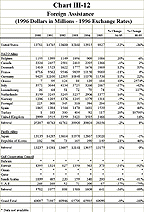
(view full–size chart)
In 1995, as in past years, the four nations with the largest foreign assistance contributions (in absolute terms) continued to be Japan, Germany, France, and the United States. This is the first time since this Report began including such statistics, however, that the United States has not ranked either first or second in this measure. At the other end of the spectrum are those nations that contribute very modest amounts of foreign aid, although this may be justified in the case of countries with relatively low standards of living (e.g., Turkey, the Republic of Korea, Greece, and Portugal).
Chart III–12 also shows that many nations experienced significant real increases or decreases in foreign aid contributions from 1994 to 1995, producing a real decline of 8 percent for all nations in this Report combined. Reductions in foreign aid were due in part to continuing efforts by donor countries to reduce their budget deficits, as well as to a decrease in the amount of peacekeeping expenditures that qualify as foreign assistance. The greatest percentage increases in foreign assistance from 1994 levels were reported for Greece (43 percent), Turkey (28 percent), Belgium (20 percent), the Netherlands (16 percent), Denmark (12 percent) and Germany (11 percent). Nations contributing substantially less in 1995 include Saudi Arabia (–41 percent), United Arab Emirates (–37 percent), Italy (–37 percent), Kuwait (–34 percent), the United States (–32 percent), Portugal (–25 percent), and the Republic of Korea (–21 percent).
To improve the comparability of foreign assistance contributions among nations, as well as to address the issue of equity, it is necessary to consider nations’ contributions relative to their ability to contribute. This is done in Chart III–13, which compares each nation’s foreign assistance contributions to its GDP for 1995. From this perspective, the largest grant aid donors are Kuwait, Denmark, Norway, and the Netherlands (the only nations to meet or surpass UN assistance targets of 0.7 percent of GDP). Due to the dramatic reduction in U.S. foreign assistance in 1995, U.S. grant aid relative to GDP has fallen to its lowest level since such accounting was introduced in 1950. The U.S. percentage is the third lowest of all donor nations assessed in this Report, ahead of only Turkey and the Republic of Korea.
Chart III–13
Foreign Assistance as a Percent of GDP (1995)
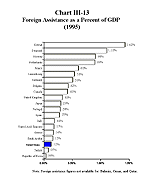
(view full–size chart)
Foreign Assistance Contributions Compared With Congressional Targets In the FY 1997 Defense Authorization Act, Congress established two targets for our allies in the area of foreign assistance: increase foreign assistance by 10 percent compared to the preceding year, or achieve a level of foreign assistance at least commensurate to that of the United States. With the exception of the Republic of Korea, every country addressed in this Report for which data are available met one or both of these Congressional targets during 1995—as shown in the following chart.
|
|
Foreign Assistance Increased by 10% | Foreign Assistance as % GDP Exceeds or Commensurate to U.S. Level |
|---|---|---|
| Belgium |

|

|
| Canada |
|

|
| Denmark |

|

|
| France |
|

|
| Germany |

|

|
| Greece |

|

|
| Italy |
|

|
| Japan |
|

|
| Kuwait |
|

|
| Luxembourg |
|

|
| Netherlands |

|

|
| Norway |
|

|
| Portugal |
|

|
| Saudi Arabia |
|

|
| Spain |
|

|
| Turkey |

|
|
| United Arab Emirates |

|
|
| United Kingdom |

|
Virtually every nation addressed in this Report satisfies at least one of the responsibility sharing targets established in the FY 1997 Defense Authorization Act, and most satisfy more than one. We believe that this overall picture is positive, but we are committed to continued efforts to convince our allies and partners to achieve and maintain adequate defense budgets, and increase their ability to participate in multinational military activities. At the same time we will continue to emphasize the importance of increased host nation support and the critical role of foreign assistance in enhancing our collective security.